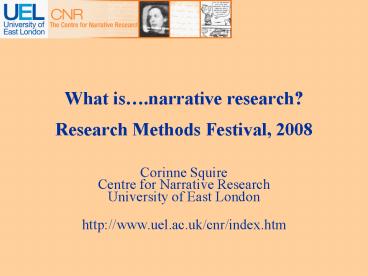What is.narrative research - PowerPoint PPT Presentation
1 / 11
Title:
What is.narrative research
Description:
Bridges theory and practice: ... Said to mediate between modernism and postmodernism. Offers different levels of analysis, from microstructure, through ... – PowerPoint PPT presentation
Number of Views:206
Avg rating:3.0/5.0
Title: What is.narrative research
1
- What is.narrative research?
- Research Methods Festival, 2008
- Corinne Squire
- Centre for Narrative Research
- University of East London
- http//www.uel.ac.uk/cnr/index.htm
2
- Why is narrative research so popular?
- Apparent universality
- Interdisciplinarity
- Bridges theory and practice academic, yet
accessible - Said to mediate between modernism and
postmodernism - Offers different levels of analysis, from
microstructure, through - content, to large-scale context
- Thought to enable relations between politics and
research - Pleasurable
3
- Problems of narrative research
- Universalised expectations about narrative
- Reification of the narrative object
- Reduction of lives to narratives
- Diversity and incompatibility of approaches
- Lack of generalisability of findings
4
- So what is narrative research?
- Narrative research in the social sciences focuses
on - Material that symbolises temporal, spatial and/or
- causal sequences, and that has particular
- objects/subjects
- Significance of these sequences (intrapersonal,
- interpersonal, social, cultural, political)
- Narrative research in the social sciences studies
- symbol sequences that are oral, written,
linguistic, - paralinguistic, visual, and behavioural
- Narrative research in the social sciences
involves - eliciting, finding or constructing narratives
- analysing narratives
- narrative analysis
5
- Approaches to narrative
- Narrative syntax Studying the structure of
naturally-occurring personal event narratives
(Labov) defined by narrative clauses studying
the functional structure of narratives (Propp) - Narrative semantics Studying the content of
stories that express experiences eg those that
map the violation and restoration of canonicity
(key/fatal moments) Bruner those that describe
some or all of a biography (Rosenthal) those
that include unconscious elements (Hollway and
Jefferson) - Narrative pragmatics 1 Studying the
co-constructed performance, across conversational
turns (Georgakopoulou) or interviews (Riessman,
Phoenix) of identity stories - Narrative pragmatics 2 Studying the
gathering-together of interpretive communities
through story genres (Plummer) studying the
relations between personal and cultural
narratives (Malson)
6
- Norriss story (Labov, 1972)
- a When I was in fourth grade -
- no, it was in third grade-
- b This boy he stole my glove.
- c He took my glove
- d and said that his father found it downtown on
the ground - (And you fight him?)
- e I told him that it was impossible for him to
- find it downtown
- cause all those people were walking by and
- just his father was the one that found it?
- f So he got all (mad).
- g Then I fought him.
- h I knocked him all out in the street.
- i So he say he give.
- j And I kept on hitting him.
- k Then he started crying
7
- Problems with the syntactic approach
- Individual, thematic and cultural variations
(Patterson) in the material that put the
universality of (eg) event narratives in question - Cognitive focus at the expense of language
- Significance of the analysis
8
- Problems with the semantic approach
- Content focus at the expense of narrative
sequence - Content focus at the expense of language
- Assumptions about the relation between narrative,
experience and selfhood - Therapeutic assumptions about good narratives
(temporal sequencing considering and resolving
conflict expressing and reflecting on emotions
reaching an ending) - Elision with politics through emphasis on giving
voice
9
- Problems of the first pragmatic approach
- Assumptions about canonic interaction patterns
based on little relevant contemporary
sociolinguistic data - Assumption of the containment of large narrative
patterns within small ones
10
- Problems of the second pragmatic approach
- Need for supporting evidence
- Lack of generalisability of the genres
- Neglect of smaller-scale phenomena, such as
individual stories - Aspects of personal and social experience that
cannot be narrated in all stories (Frosh)
11
- Short narrative bibliography
- Andrews, A., Squire, C. and Tamboukou, M. (2008)
Doing Narrative Research. London Sage - Andrews, A., Day Sclater, S., Squire, C. and
Treacher, A. (2004) Uses of Narrative. New
Brunswick, NJ Transaction - Bruner, J. (1990) Acts of Meaning Cambridge, MA
Harvard University Press. - Elliott, J. (2005) Using Narrative in Social
Research Qualitative and Quantitative
Approaches, London, Sage. - Freeman, M. Identity and difference in
narrative inquiry, Psychoanalytic narratives
Writing the self into contemporary cultural
phenomena, Narrative Inquiry 11 - Frosh, S. (2002) After Words. London Palgrave
- Georgakopoulou, A. (2007) Small Stories,
Interaction and Identities. Amsterdam John
Benjamins - Hollway, W. and Jefferson, T. (2000) Doing
Qualitative Research Differently Free
Association, Narrative and the Interview Method,
London, Sage. - Labov, W. (1972) Language in the Inner City
Studies in the Black English Vernacular Oxford
Basil Blackwell also see his website - Malson, H. (2004) Fictional(ising) identity?
Ontological assumptions and methodological
productions of (anorexic) subjectivities. in
M.Andrews, S.D.Sclater, C.Squire and A.Treacher
(eds) Uses of Narrative. New Brunswick, NJ
Transaction. - Mishler, E. (1986) Research Interviewing
Context and Narrative. Cambridge, MA Harvard
University Press. - Patterson, W. (2002) (ed.) Strategic Narrative
new perspectives on the power of stories. Oxford
Lexington. - Phoenix, A.(2008) Analysing narrative contexts.
In M.Andrews, C.Squire and M.Tamboukou (eds)
Doing Narrative Research. London Sage. - Plummer, K. (2001) Documents of Life 2. London
Sage. - Riessman, C. (2007) Narrative Methods for the
Human Sciences. New York Sage - Ryan, M-L. (2004) Narrative Across Media The
Languages of Storytelling. Lincoln University of
Nebraska Press - Seale, C. (2000) Resurrective practice and
narrative, in M.Andrews, S.D.Sclater, C.Squire
and A.Treacher (eds) Uses of Narrative. New
Brunswick, NJ Transaction - Narrative Inquiry



























![❤[READ]❤ Reflexive Narrative: Self-Inquiry Toward Self-Realization and Its Performance PowerPoint PPT Presentation](https://s3.amazonaws.com/images.powershow.com/10051051.th0.jpg?_=20240608098)
![⚡Read✔[PDF] Engaging in Narrative Inquiries with Children and Youth (Developing PowerPoint PPT Presentation](https://s3.amazonaws.com/images.powershow.com/10051151.th0.jpg?_=202406081010)


